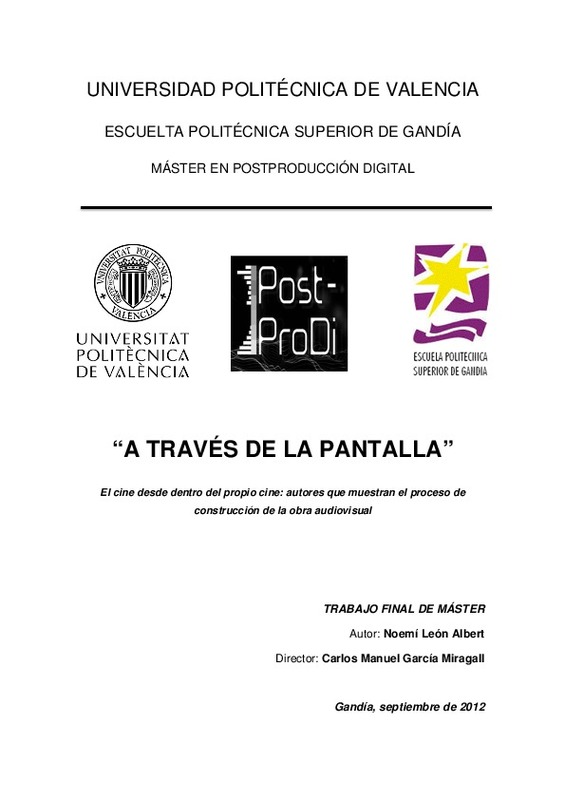JavaScript is disabled for your browser. Some features of this site may not work without it.
Buscar en RiuNet
Listar
Mi cuenta
Estadísticas
Ayuda RiuNet
Admin. UPV
A través de la Pantalla
Mostrar el registro sencillo del ítem
Ficheros en el ítem
| dc.contributor.advisor | García Miragall, Carlos Manuel
|
es_ES |
| dc.contributor.author | León Albert, Noemí
|
es_ES |
| dc.date.accessioned | 2013-02-01T09:45:16Z | |
| dc.date.available | 2013-02-01T09:45:16Z | |
| dc.date.created | 2012-09-05 | |
| dc.date.issued | 2013-02-01 | |
| dc.identifier.uri | http://hdl.handle.net/10251/19144 | |
| dc.description.abstract | El objetivo de esta Tesina es analizar este cine visto desde dentro del propio cine. En primer lugar comentaré el estándar de cine existente actualmente, basado en la creación de una ilusión de realidad, una objetividad ficticia, que absorbe al espectador. En contraposición, mostraré una manera de hacer cine totalmente diferente, donde se evidencia que tras las imágenes rodadas hay un proceso de manipulación técnica. Para ello haré un recorrido por películas que han tratado el cine de esta manera tan diferente, desde los inicios, como El Hombre de la Cámara de Dziga Vértov (1929) hasta el cine experimental actual, como Steps, de Zbigniew Rybczynski (1987). Para poner en práctica esta manera de concebir el cine, mi proyecto consiste en un cortometraje en el cual un personaje entra dentro de la televisión, metiéndose dentro de este montaje, de esta manipulación técnica, y viviéndola desde dentro. Así, el protagonista hará un recorrido por un zapping de películas que han sido famosas a lo largo de la historia del cine, pero no como un mero espectador, sino viviéndolas desde dentro y siendo partícipe de las historias que en ellas se cuentan. Este corto quiere reflejar diversas cosas que abordaré en esta Tesina: por una parte, reflejar la absorción que el cine hace del espectador, haciéndole partícipe de la propia película, como si de una realidad se tratara, escondiendo cualquier tipo de evidencia del montaje y manipulación técnica que sufren las imágenes. Y, por otra parte, hacer evidente que este montaje existe, sobreponiendo a través de técnicas como el croma key y la rotoscopia, al protagonista dentro de las secuencias de las diversas películas. | es_ES |
| dc.description.abstract | The objective of this Thesis is to analyse the cinema from inside the cinema itself. In the first place I'll comment the actual cinema standard, based in the creation of a reality illusion, a fictitious objectivity, which absorbs the spectator. Instead, I'll show a completely different way of making a cinema film, where it's evident that, behind the filmed scenes, there's a technical manipulation process. For that, I'll make a way through movies that have dealt with the cinema in this completely different ways, from the beginning, like The Man with the Movie Camera, by Dziga Vértov (1929), to the actual experimental cinema, like Steps, by Zbigniew Rybczynski (1987). To test this way of seeing the cinema, my project consists in a short film, in which the character enters inside the own television, inside the mounting process, the technical manipulation, and living it from inside. Like this, the protagonist will make a way through a zapping of different movies that have been famous through the history of the cinema, but not like a spectator, but living them from inside, and participating in the stories told in them. This short film wants to show different things that I will explain further in this Thesis: on one side, to reflect the absorption produced on the spectators by the cinema, hiding any kind of mounting process or technical manipulation suffered by the images. And, on the other side, to make evident the existence of a mounting process, superimposing through technics like the chroma key and the rotoscopy, the protagonist inside the scenes of several different movies. | es_ES |
| dc.format.extent | 89 | es_ES |
| dc.language | Español | es_ES |
| dc.publisher | Universitat Politècnica de València | es_ES |
| dc.rights | Reconocimiento - No comercial - Sin obra derivada (by-nc-nd) | es_ES |
| dc.subject | Reality illusion | es_ES |
| dc.subject | Technical manipulation | es_ES |
| dc.subject | Spectator | es_ES |
| dc.subject | Chroma-key | es_ES |
| dc.subject | Rotoscopy | es_ES |
| dc.subject | Ilusión de realidad, | es_ES |
| dc.subject | Manipulación técnica | es_ES |
| dc.subject | Espectador | es_ES |
| dc.subject | Rotoscopia | es_ES |
| dc.subject.other | Máster Universitario en Postproducción Digital-Màster Universitari en Postproducció Digital | es_ES |
| dc.title | A través de la Pantalla | es_ES |
| dc.type | Tesis de máster | es_ES |
| dc.rights.accessRights | Abierto | es_ES |
| dc.contributor.affiliation | Universitat Politècnica de València. Departamento de Escultura - Departament d'Escultura | es_ES |
| dc.contributor.affiliation | Universitat Politècnica de València. Facultad de Bellas Artes - Facultat de Belles Arts | es_ES |
| dc.contributor.affiliation | Universitat Politècnica de València. Departamento de Sistemas Informáticos y Computación - Departament de Sistemes Informàtics i Computació | es_ES |
| dc.description.bibliographicCitation | León Albert, N. (2012). A través de la Pantalla. Universitat Politècnica de València. http://hdl.handle.net/10251/19144 | es_ES |
| dc.description.accrualMethod | Archivo delegado | es_ES |
Este ítem aparece en la(s) siguiente(s) colección(ones)
-
EPSG - Trabajos académicos [5004]
Escuela Politécnica Superior de Gandia






